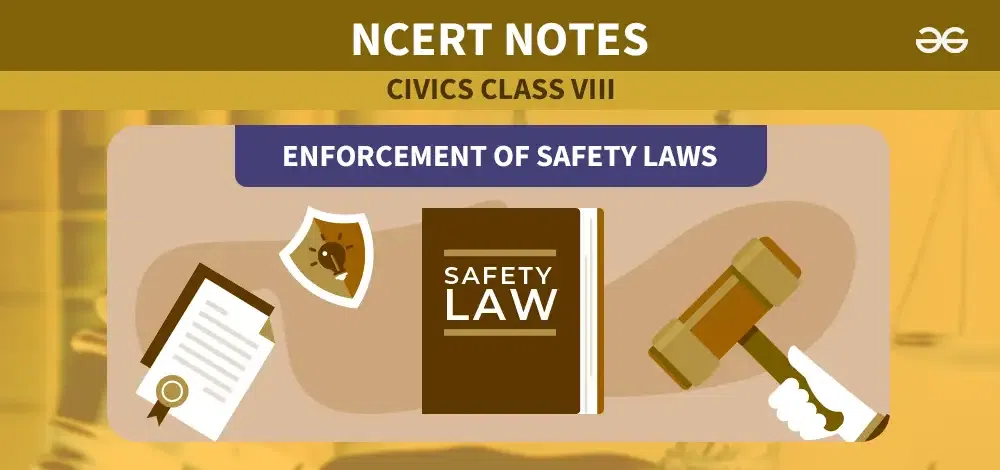Enforcement of Safety Laws| Class 8 Polity Notes
Last Updated :
10 Apr, 2024
In every society, ensuring the safety and well-being of its citizens is paramount. Safety laws serve as the foundation for protecting individuals from harm, whether in the workplace, on the road, or in public spaces. However, the effectiveness of these laws hinges on their enforcement. In this article, we delve into the critical importance of enforcing safety laws, examining its role in promoting a culture of safety, deterring violations, and ultimately saving lives.

Enforcement of Safety Laws – Class 8 Notes
Setting the Standard
Safety laws establish clear guidelines and standards for various aspects of life, including occupational safety, transportation, consumer products, and public health. These laws are designed to prevent accidents, injuries, and fatalities by outlining safety protocols, requirements, and best practices. Whether it’s wearing seat belts, installing smoke detectors, or implementing workplace safety measures, safety laws set the bar for protecting individuals and communities.
Promoting a Culture of Safety
Effective enforcement of safety laws fosters a culture of safety where compliance becomes the norm rather than the exception. By consistently enforcing safety regulations, authorities send a powerful message that safety is a priority and non-compliance will not be tolerated. This helps cultivate awareness, accountability, and responsibility among individuals, businesses, and organizations, leading to safer practices and environments.
Deterring Violations
Enforcement serves as a deterrent against violations of safety laws by imposing consequences for non-compliance. Whether through fines, penalties, or legal action, enforcement mechanisms send a clear signal that violating safety regulations carries serious repercussions. This not only holds offenders accountable but also discourages others from engaging in risky behavior or cutting corners when it comes to safety.
Protecting Vulnerable Populations
Enforcement of safety laws is particularly crucial for protecting vulnerable populations, including workers, children, the elderly, and individuals with disabilities. Workplace safety regulations, for example, safeguard workers from hazardous conditions and ensure they have access to protective equipment and training. Child safety laws, such as car seat regulations and playground standards, help prevent accidents and injuries among young children. By enforcing these laws, authorities help safeguard the most vulnerable members of society.
Saving Lives and Preventing Injuries
At its core, the enforcement of safety laws is about saving lives and preventing injuries. Whether it’s enforcing speed limits to reduce traffic accidents, conducting inspections to ensure building safety standards, or monitoring food and drug regulations to protect public health, enforcement efforts directly contribute to saving lives and reducing the burden of injuries on society. Every citation issued, every violation addressed, and every safety measure enforced has the potential to prevent tragedies and preserve human life.
Upholding Public Trust and Confidence
Effective enforcement of safety laws is essential for upholding public trust and confidence in government institutions and regulatory agencies. When individuals see that safety regulations are consistently enforced and violations are addressed swiftly and fairly, they are more likely to have faith in the system and comply with the law voluntarily. This strengthens the social contract between citizens and authorities, fostering a sense of security and stability within communities.
Collaboration and Partnership
Enforcement of safety laws is a collaborative effort that requires cooperation and partnership among various stakeholders, including government agencies, law enforcement, regulatory bodies, businesses, advocacy groups, and the public. By working together, these entities can pool resources, share information, and coordinate efforts to enhance enforcement effectiveness and address emerging safety challenges.
Continuous Improvement and Adaptation
As society evolves and new safety risks emerge, enforcement strategies must also adapt and evolve to effectively address changing needs and circumstances. This requires ongoing evaluation, monitoring, and feedback mechanisms to identify gaps in enforcement, assess effectiveness, and implement improvements. By continuously refining enforcement approaches and embracing innovation, authorities can stay ahead of emerging safety threats and better protect the public.
Conclusion
Enforcement of safety laws is not merely about punishment; it is about protection, prevention, and preservation of life. By upholding safety standards, promoting compliance, and deterring violations, enforcement efforts play a crucial role in safeguarding individuals, communities, and society as a whole. From promoting a culture of safety to saving lives and fostering public trust, effective enforcement of safety laws is essential for creating safer, healthier, and more resilient communities now and in the future.
Share your thoughts in the comments
Please Login to comment...